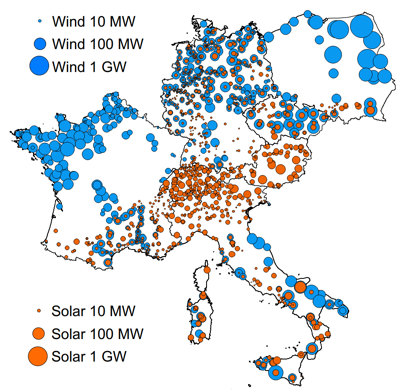Optimal Renewables Portfolio to Achieve 45% Renewable Electricity in Central Europe by 2030
Unlike the EU’s 2020 energy strategy, in its 2030 energy strategy, the EU seeks to achieve a target of 45% renewable-generated electricity with no binding national targets for each member state. This leaves opens the question of what is the optimal allocation of new renewable installations across Europe?
EnerPol, the Laboratory for Energy Conversion’s in-house developed, bottom-up, scenario-based, simulation framework is used to determine the optimal wind and solar portfolio. Within the EnerPol framework, a power systems model for central Europe that is comprised of all individual conventional and renewable power plants, all high voltage transmission lines, and geographically-referenced demand of differentiated by end-users is used. Full-year hourly simulations of this power system for the year 2030 are iteratively conducted with a machine-learning algorithm in order to determine the optimal wind and solar portfolio that minimises the curtailment (that is, temporary stop of renewable plant operation), the residual load fluctuations (that is, difference between electricity load and renewable generation), and the length of transmission lines that require upgrade. This optimal portfolio comprises 221 GW of new wind installations and 82 GW of new solar installations – see Table and graphic.
It is evident that there are substantial technical and financial benefits of coordinating national efforts towards a low-carbon energy sector, as opposed to national optimum portfolios.

This study was awarded the Best Conference Paper Award at the 2017 IEEE Power and Energy Society General Meeting held 16-20 July 2017 in Chicago USA.
The ESC Member involved in this project is Professor Reza Abhari who has been full professor of energy technologies and the Director of the Laboratory for Energy Conversion (LEC) at ETH Zürich since 1999. His group focuses on research developing break-through technologies for a broad range of scientific and technological areas with societal impact. Current research involves analytical, computational and experimental research and education related to technology and economics of turbomachinery, wind energy, advanced diagnostic sensor and actuator technologies, semiconductor industries, and data-driven decision-making for policy.